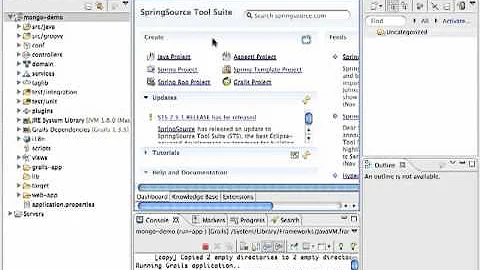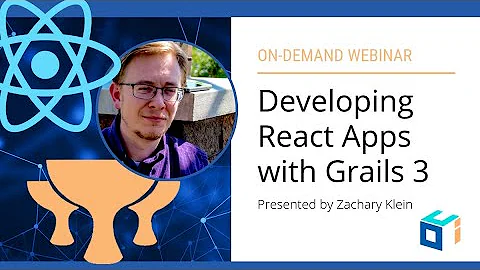Grails JSONBuilder
Solution 1
I finally figured out how to do this using a JSONBuilder, here's the code
import grails.web.*
class JSONSerializer {
def target
String getJSON() {
Closure jsonFormat = {
object = {
// Set the delegate of buildJSON to ensure that missing methods called thereby are routed to the JSONBuilder
buildJSON.delegate = delegate
buildJSON(target)
}
}
def json = new JSONBuilder().build(jsonFormat)
return json.toString(true)
}
private buildJSON = {obj ->
obj.properties.each {propName, propValue ->
if (!['class', 'metaClass'].contains(propName)) {
if (isSimple(propValue)) {
// It seems "propName = propValue" doesn't work when propName is dynamic so we need to
// set the property on the builder using this syntax instead
setProperty(propName, propValue)
} else {
// create a nested JSON object and recursively call this function to serialize it
Closure nestedObject = {
buildJSON(propValue)
}
setProperty(propName, nestedObject)
}
}
}
}
/**
* A simple object is one that can be set directly as the value of a JSON property, examples include strings,
* numbers, booleans, etc.
*
* @param propValue
* @return
*/
private boolean isSimple(propValue) {
// This is a bit simplistic as an object might very well be Serializable but have properties that we want
// to render in JSON as a nested object. If we run into this issue, replace the test below with an test
// for whether propValue is an instanceof Number, String, Boolean, Char, etc.
propValue instanceof Serializable || propValue == null
}
}
You can test this by pasting the code above along with the following into the grails console
// Define a class we'll use to test the builder
class Complex {
String name
def nest2 = new Expando(p1: 'val1', p2: 'val2')
def nest1 = new Expando(p1: 'val1', p2: 'val2')
}
// test the class
new JSONSerializer(target: new Complex()).getJSON()
It should generate the following output which stores the serialized instance of Complex as the value of the object property:
{"object": {
"nest2": {
"p2": "val2",
"p1": "val1"
},
"nest1": {
"p2": "val2",
"p1": "val1"
},
"name": null
}}
Solution 2
In order for the converter to convert the whole object structure you need to set a property in the config to indicate that, otherwise it will just include the ID of the child object, so you need to add this:
grails.converters.json.default.deep = true
For more information go Grails Converters Reference.
However, like you mentioned it in the comment above it is all or nothing, so what you can do is create your own marshaller for your class. I had to do this before because I needed to include some very specific properties, so what I did was that I created a class that extends org.codehaus.groovy.grails.web.converters.marshaller.json.DomainClassMarshaller. Something like:
class MyDomainClassJSONMarshaller extends DomainClassMarshaller {
public MyDomainClassJSONMarshaller() {
super(false)
}
@Override
public boolean supports(Object o) {
return (ConverterUtil.isDomainClass(o.getClass()) &&
(o instanceof MyDomain))
}
@Override
public void marshalObject(Object value, JSON json) throws ConverterException {
JSONWriter writer = json.getWriter();
Class clazz = value.getClass();
GrailsDomainClass domainClass = ConverterUtil.getDomainClass(clazz.getName());
BeanWrapper beanWrapper = new BeanWrapperImpl(value);
writer.object();
writer.key("class").value(domainClass.getClazz().getName());
GrailsDomainClassProperty id = domainClass.getIdentifier();
Object idValue = extractValue(value, id);
json.property("id", idValue);
GrailsDomainClassProperty[] properties = domainClass.getPersistentProperties();
for (GrailsDomainClassProperty property: properties) {
if (!DomainClassHelper.isTransient(transientProperties, property)) {
if (!property.isAssociation()) {
writer.key(property.getName());
// Write non-relation property
Object val = beanWrapper.getPropertyValue(property.getName());
json.convertAnother(val);
} else {
Object referenceObject = beanWrapper.getPropertyValue(property.getName());
if (referenceObject == null) {
writer.key(property.getName());
writer.value(null);
} else {
if (referenceObject instanceof AbstractPersistentCollection) {
if (isRenderDomainClassRelations(value)) {
writer.key(property.getName());
// Force initialisation and get a non-persistent Collection Type
AbstractPersistentCollection acol = (AbstractPersistentCollection) referenceObject;
acol.forceInitialization();
if (referenceObject instanceof SortedMap) {
referenceObject = new TreeMap((SortedMap) referenceObject);
} else if (referenceObject instanceof SortedSet) {
referenceObject = new TreeSet((SortedSet) referenceObject);
} else if (referenceObject instanceof Set) {
referenceObject = new HashSet((Set) referenceObject);
} else if (referenceObject instanceof Map) {
referenceObject = new HashMap((Map) referenceObject);
} else {
referenceObject = new ArrayList((Collection) referenceObject);
}
json.convertAnother(referenceObject);
}
} else {
writer.key(property.getName());
if (!Hibernate.isInitialized(referenceObject)) {
Hibernate.initialize(referenceObject);
}
json.convertAnother(referenceObject);
}
}
}
}
}
writer.endObject();
}
...
}
That code above is pretty much the same code as it is DomainClassMarshaller, the idea would be that you add or remove what you need.
Then in order for Grails to use this new converter what you need is to register it in the resources.groovy file, like this:
// Here we are regitering our own domain class JSON Marshaller for MyDomain class
myDomainClassJSONObjectMarshallerRegisterer(ObjectMarshallerRegisterer) {
converterClass = grails.converters.JSON.class
marshaller = {MyDomainClassJSONMarshaller myDomainClassJSONObjectMarshaller ->
// nothing to configure, just need the instance
}
priority = 10
}
As you can see this marshaller works for a specific class, so if you want to make more generic what you can do is create a super class and make your classes inherit from that so in the support method what you do is say this marshaller support all the classes that are instances of that super class.
My suggestion is to review the grails code for the converters, that will give you an idea of how they work internally and then how you can extend it so it works the way you need.
This other post in Nabble might be of help too.
Also, if you need to do it for XML as well then you just extend the class org.codehaus.groovy.grails.web.converters.marshaller.xml.DomainClassMarshaller and follow the same process to register it, etc.
Related videos on Youtube
Dónal
I earn a living by editing text files. I can be contacted at: [email protected] You can find out about all the different kinds of text files I've edited at: My StackOverflow Careers profile
Updated on April 05, 2020Comments
-
Dónal about 4 years
If I have a simple object such as
class Person { String name Integer age }I can easily render it's user-defined properties as JSON using the JSONBuilder
def person = new Person(name: 'bob', age: 22) def builder = new JSONBuilder.build { person.properties.each {propName, propValue -> if (!['class', 'metaClass'].contains(propName)) { // It seems "propName = propValue" doesn't work when propName is dynamic so we need to // set the property on the builder using this syntax instead setProperty(propName, propValue) } } def json = builder.toString()This works fine when the properties are simple, i.e. numbers or strings. However for a more complex object such as
class ComplexPerson { Name name Integer age Address address } class Name { String first String second } class Address { Integer houseNumber String streetName String country }Is there a way that I can walk the entire object graph, adding each user-defined property at the appropriate nesting level to the JSONBuilder?
In other words, for an instance of
ComplexPersonI would like the output to be{ name: { first: 'john', second: 'doe' }, age: 20, address: { houseNumber: 123, streetName: 'Evergreen Terrace', country: 'Iraq' } }Update
I don't think I can use the Grails JSON converter to do this because the actual JSON structure I'm returning looks something like
{ status: false, message: "some message", object: // JSON for person goes here }Notice that:
- The JSON generated for the
ComplexPersonis an element of a larger JSON object - I want to exclude certain properties such as
metaClassandclassfrom the JSON conversion
If it's possible to get the output of the JSON converter as an object, I could iterate over that and remove the
metaClassandclassproperties, then add it to the outer JSON object.However, as far as I can tell, the JSON converter only seems to offer an "all or nothing" approach and returns it output as a String
- The JSON generated for the
-
Dónal about 13 yearsThanks a lot, this looks very helpful
-
Maricel about 13 yearsHope it works, I think you can create a very customized converter with this so it does what you need :-)









